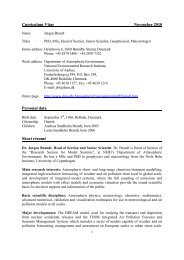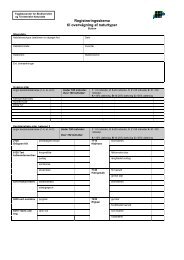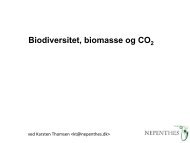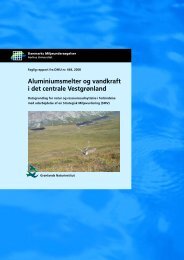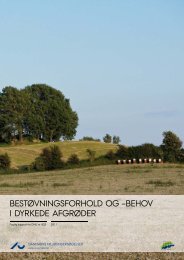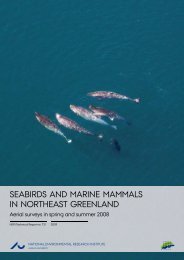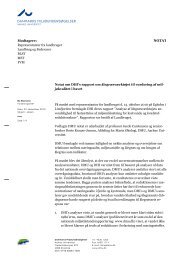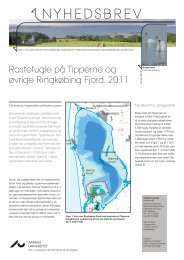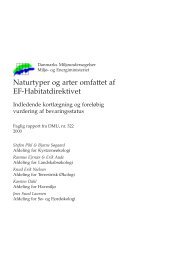Spatial distribution of emissions to air - the SPREAD model
Spatial distribution of emissions to air - the SPREAD model
Spatial distribution of emissions to air - the SPREAD model
You also want an ePaper? Increase the reach of your titles
YUMPU automatically turns print PDFs into web optimized ePapers that Google loves.
40<br />
As lined out <strong>the</strong> agricultural sec<strong>to</strong>r covers a number <strong>of</strong> sources, which<br />
are distributed according <strong>to</strong> different spatial keys. Emissions from <strong>the</strong><br />
agricultural sources are calculated with a bot<strong>to</strong>m-up approach for <strong>the</strong><br />
spatial <strong>distribution</strong>. The bot<strong>to</strong>m-up calculation is carried out on a<br />
100x100 m grid, which is aggregated in<strong>to</strong> a 1x1 km grid in <strong>SPREAD</strong>.<br />
The <strong>emissions</strong> estimated by <strong>the</strong> bot<strong>to</strong>m-up approach are not completely<br />
consistent with <strong>the</strong> <strong>emissions</strong> in <strong>the</strong> national inven<strong>to</strong>ry, which are calculated<br />
with a <strong>to</strong>p-down approach as <strong>the</strong> emission calculation must be consistent<br />
with <strong>the</strong> national statistics. In order <strong>to</strong> ensure that <strong>the</strong> <strong>emissions</strong><br />
in <strong>SPREAD</strong> are equal <strong>to</strong> <strong>the</strong> reported <strong>emissions</strong> for 2008, <strong>the</strong> reported<br />
<strong>emissions</strong> are distributed according <strong>to</strong> <strong>the</strong> <strong>distribution</strong> keys set up by <strong>the</strong><br />
bot<strong>to</strong>m-up approach.<br />
(QWHULF )HUPHQWDWLRQ<br />
CH4 from enteric fermentation is distributed according <strong>to</strong> data on <strong>the</strong><br />
number and categories <strong>of</strong> animals on farm level. CHR holds data for <strong>the</strong><br />
majority <strong>of</strong> <strong>the</strong> lives<strong>to</strong>ck covering animal-categories related <strong>to</strong> e.g. breed<br />
and age (e.g. calf, heifer and cow or sow and piglets) and use (e.g. d<strong>air</strong>y<br />
cattle and beef cattle). The horse breeding register holds addresses <strong>of</strong> <strong>the</strong><br />
owners, and this is <strong>the</strong> best dataset for spatial <strong>distribution</strong> <strong>of</strong> <strong>emissions</strong><br />
from horses even though <strong>the</strong> horses might be located at different sites<br />
than <strong>the</strong> owners address. As <strong>the</strong> register for horses does not hold information<br />
on pasture areas, <strong>emissions</strong> from both stables, s<strong>to</strong>rage and grazing<br />
are located at <strong>the</strong> owners address.<br />
0DQXUH 0DQDJHPHQW<br />
The <strong>distribution</strong> <strong>of</strong> CH4, N2O, NH3, TSP, PM10 and PM2.5 from manure<br />
management is based on <strong>the</strong> data from GLR and CHR. As for enteric<br />
fermentation <strong>the</strong> location <strong>of</strong> <strong>the</strong> animals, housing systems and manure<br />
systems is important for <strong>distribution</strong> <strong>of</strong> <strong>emissions</strong> from manure management.<br />
Emissions <strong>of</strong> NH3 from manure management are related <strong>to</strong> activities at<br />
<strong>the</strong> farms and are treated as point sources. Calculations are based on <strong>the</strong><br />
normative figures on N-excretion per farm corrected for grazing. As for<br />
enteric fermentation data <strong>the</strong> horse breeding register is included in <strong>the</strong><br />
calculation.<br />
$JULFXOWXUDO VRLOV<br />
Agricultural soils covers ten sources; crops, application <strong>of</strong> manure, application<br />
<strong>of</strong> syn<strong>the</strong>tic fertiliser, N-excretion on pasture range and paddock,<br />
NH3 treated straw, crop residue, N-fixing crops, cultivation <strong>of</strong> his<strong>to</strong>sols,<br />
leaching and atmospheric deposition. Emissions <strong>of</strong> NMVOC, N2O<br />
and NH3 are included in one or more <strong>of</strong> <strong>the</strong> sources.





